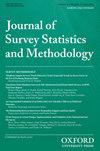从免疫信息系统构建州和国家疫苗接种率估计
IF 1.6
4区 数学
Q2 SOCIAL SCIENCES, MATHEMATICAL METHODS
引用次数: 1
摘要
免疫信息系统是一种保密的基于人群的计算机化系统,从疫苗接种提供者那里收集个人疫苗接种的数据,以及有限的患者水平特征。通过数据使用协议,疾病控制和预防中心获得个人层面的数据,并汇总美国人口普查局(县或同等统计实体)为系统中包含的每种疫苗定义的地理统计区域的疫苗接种数量。目前,覆盖11个州的599个县使用统一协议收集和报告数据。我们将这些数据与美国人口普查局人口估计项目的十年一次的人口统计以及各种来源的几个协变量相结合,为50个州和哥伦比亚特区的3142个县中的每个县制定基于模型的估计,然后汇总到州和国家层面。我们使用分层贝叶斯模型和马尔可夫链蒙特卡罗方法从疫苗接种率的后验预测分布中获得结果。我们使用后验预测检验和交叉验证来评估拟合优度并验证模型。我们还将基于模型的估计与国家免疫调查的直接估计进行了比较。本文章由计算机程序翻译,如有差异,请以英文原文为准。
Constructing State and National Estimates of Vaccination Rates from Immunization Information Systems
Immunization Information Systems are confidential computerized population-based systems that collect data from vaccination providers on individual vaccinations administered along with limited patient-level characteristics. Through a data use agreement, Centers for Disease Control and Prevention obtains the individual-level data and aggregates the number of vaccinations for geographical statistical areas defined by the US Census Bureau (counties or equivalent statistical entities) for each vaccine included in system. Currently, 599 counties, covering 11 states, collect and report data using a uniform protocol. We combine these data with inter-decennial population counts from the Population Estimates Program in the US Census Bureau and several covariates from a variety of sources to develop model-based estimates for each of the 3,142 counties in 50 states and the District of Columbia and then aggregate to the state and national levels. We use a hierarchical Bayesian model and Markov Chain Monte Carlo methods to obtain draws from the posterior predictive distribution of the vaccination rates. We use posterior predictive checks and cross-validation to assess the goodness of fit and to validate the models. We also compare the model-based estimates to direct estimates from the National Immunization Surveys.
求助全文
通过发布文献求助,成功后即可免费获取论文全文。
去求助
来源期刊
CiteScore
4.30
自引率
9.50%
发文量
40
期刊介绍:
The Journal of Survey Statistics and Methodology, sponsored by AAPOR and the American Statistical Association, began publishing in 2013. Its objective is to publish cutting edge scholarly articles on statistical and methodological issues for sample surveys, censuses, administrative record systems, and other related data. It aims to be the flagship journal for research on survey statistics and methodology. Topics of interest include survey sample design, statistical inference, nonresponse, measurement error, the effects of modes of data collection, paradata and responsive survey design, combining data from multiple sources, record linkage, disclosure limitation, and other issues in survey statistics and methodology. The journal publishes both theoretical and applied papers, provided the theory is motivated by an important applied problem and the applied papers report on research that contributes generalizable knowledge to the field. Review papers are also welcomed. Papers on a broad range of surveys are encouraged, including (but not limited to) surveys concerning business, economics, marketing research, social science, environment, epidemiology, biostatistics and official statistics. The journal has three sections. The Survey Statistics section presents papers on innovative sampling procedures, imputation, weighting, measures of uncertainty, small area inference, new methods of analysis, and other statistical issues related to surveys. The Survey Methodology section presents papers that focus on methodological research, including methodological experiments, methods of data collection and use of paradata. The Applications section contains papers involving innovative applications of methods and providing practical contributions and guidance, and/or significant new findings.

 求助内容:
求助内容: 应助结果提醒方式:
应助结果提醒方式:


